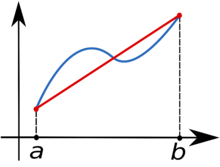在數值分析 上,梯形法則 和辛卜生法則 均是數值積分 的方法。它們都是計算定積分 的。
這兩種方法都屬於牛頓-寇次公式 。它們以函數於等距
n
+
1
{\displaystyle n+1}
n
{\displaystyle n}
多項式 來近似原來的函數,再行求積。
原函數(藍色)近似為紅色的線性函數 多重梯形法則 梯形法則 是:
∫
a
b
f
(
x
)
d
x
≈
(
b
−
a
)
f
(
a
)
+
f
(
b
)
2
.
{\displaystyle \int _{a}^{b}f(x)\,dx\approx (b-a){\frac {f(a)+f(b)}{2}.}
這等同將被積函數近似為直線 函數,被積的部分近似為梯形 。
要求得較準確的數值,可以將要求積的區間分成多個小區間,再個別估計,即:
∫
a
b
f
(
x
)
d
x
≈
b
−
a
n
(
f
(
a
)
+
f
(
b
)
2
+
∑
k
=
1
n
−
1
f
(
a
+
k
b
−
a
n
)
)
.
{\displaystyle \int _{a}^{b}f(x)\,dx\approx {\frac {b-a}{n}\left({f(a)+f(b) \over 2}+\sum _{k=1}^{n-1}f\left(a+k{\frac {b-a}{n}\right)\right).}
可改寫成
∫
a
b
f
(
x
)
d
x
≈
b
−
a
2
n
(
f
(
x
0
)
+
2
f
(
x
1
)
+
2
f
(
x
2
)
+
⋯
+
2
f
(
x
n
−
1
)
+
f
(
x
n
)
)
{\displaystyle \int _{a}^{b}f(x)\,dx\approx {\frac {b-a}{2n}\left(f(x_{0})+2f(x_{1})+2f(x_{2})+\cdots +2f(x_{n-1})+f(x_{n})\right)}
其中
對
k
=
0
,
1
,
…
,
n
{\displaystyle k=0,1,\dots ,n}
x
k
=
a
+
k
b
−
a
n
,
{\displaystyle x_{k}=a+k{\frac {b-a}{n},}
辛普森法则 (Simpson's rule,又稱森遜法則 )是:
∫
a
b
f
(
x
)
d
x
≈
b
−
a
6
[
f
(
a
)
+
4
f
(
a
+
b
2
)
+
f
(
b
)
]
.
{\displaystyle \int _{a}^{b}f(x)\,dx\approx {\frac {b-a}{6}\left[f(a)+4f\left({\frac {a+b}{2}\right)+f(b)\right].}
同樣地,辛普森法则也有多重的版本:
∫
a
b
f
(
x
)
d
x
≈
h
3
⋅
[
f
(
x
0
)
+
2
∑
k
=
1
n
−
1
f
(
x
k
)
+
4
∑
k
=
1
n
f
(
x
k
−
1
+
x
k
2
)
+
f
(
x
n
)
]
{\displaystyle \int _{a}^{b}f(x)\,dx\approx {\frac {h}{3}\cdot \left[f(x_{0})+2\sum _{k=1}^{n-1}f(x_{k})+4\sum _{k=1}^{n}f\left({\frac {x_{k-1}+x_{k}{2}\right)+f(x_{n})\right]}
h
=
b
−
a
n
,
x
k
=
a
+
k
⋅
h
.
{\displaystyle h={\frac {b-a}{n},\ x_{k}=a+k\cdot h.}
或寫成
∫
a
b
f
(
x
)
d
x
≈
h
3
[
f
(
x
0
)
+
4
f
(
x
1
)
+
2
f
(
x
2
)
+
4
f
(
x
3
)
+
2
f
(
x
4
)
+
⋯
+
4
f
(
x
n
−
1
)
+
f
(
x
n
)
]
{\displaystyle \int _{a}^{b}f(x)\,dx\approx {\frac {h}{3}{\bigg [}f(x_{0})+4f(x_{1})+2f(x_{2})+4f(x_{3})+2f(x_{4})+\cdots +4f(x_{n-1})+f(x_{n}){\bigg ]}
牛頓-寇次公式(Newton-Cotes rule / Newton-Cotes formula)以Roger Cotes和艾薩克·牛頓 命名。其內容是:
∫
a
b
f
(
x
)
d
x
≈
∑
i
=
0
n
w
i
f
(
x
i
)
{\displaystyle \int _{a}^{b}f(x)\,dx\approx \sum _{i=0}^{n}w_{i}\,f(x_{i})}
其中對
k
=
0
,
1
,
…
,
n
{\displaystyle k=0,1,\dots ,n}
w
i
{\displaystyle w_{i}
n
{\displaystyle n}
x
k
=
a
+
k
b
−
a
n
{\displaystyle x_{k}=a+k{\frac {b-a}{n}
梯形法則和辛卜生法則便是
n
=
1
,
2
{\displaystyle n=1,2}
亦有不採用在邊界點來估計的版本,即取
x
k
=
a
+
k
b
−
a
n
+
1
{\displaystyle x_{k}=a+k{\frac {b-a}{n+1}
假設已知
f
(
x
0
)
,
f
(
x
1
)
,
…
,
f
(
x
n
)
{\displaystyle f(x_{0}),f(x_{1}),\dots ,f(x_{n})}
以
n
+
1
{\displaystyle n+1}
插值 ,求得對應
f
(
x
)
{\displaystyle f(x)}
拉格朗日多項式 。
對該
n
{\displaystyle n}
該積分便可以作為
∫
a
b
f
(
x
)
d
x
{\displaystyle \int _{a}^{b}f(x)\,dx}
n
{\displaystyle n}
w
i
{\displaystyle w_{i}
對於次數較高的多項式而有很大誤差(龍格現象 ),不如高斯積分法 。
下表中
f
i
=
f
(
x
i
)
{\displaystyle f_{i}=f(x_{i})}
ξ
∈
[
a
,
b
]
{\displaystyle \xi \in [a,b]}
h
=
b
−
a
{\displaystyle h=b-a}
精度
名稱
公式
誤差
1
梯形法則
h
2
(
f
0
+
f
1
)
{\displaystyle {\frac {h}{2}(f_{0}+f_{1})}
−
2
h
3
3
f
(
2
)
(
ξ
)
{\displaystyle -{\frac {2h^{3}{3}\,f^{(2)}(\xi )}
2
辛卜生法則
h
6
(
f
0
+
4
f
1
+
f
2
)
{\displaystyle {\frac {h}{6}(f_{0}+4f_{1}+f_{2})}
−
h
5
90
f
(
4
)
(
ξ
)
{\displaystyle -{\frac {h^{5}{90}\,f^{(4)}(\xi )}
3
辛卜生3/8法則
h
8
(
f
0
+
3
f
1
+
3
f
2
+
f
3
)
{\displaystyle {\frac {h}{8}(f_{0}+3f_{1}+3f_{2}+f_{3})}
−
3
h
5
80
f
(
4
)
(
ξ
)
{\displaystyle -{\frac {3h^{5}{80}\,f^{(4)}(\xi )}
4
保爾法則
2
h
45
(
7
f
0
+
32
f
1
+
12
f
2
+
32
f
3
+
7
f
4
)
{\displaystyle {\frac {2h}{45}(7f_{0}+32f_{1}+12f_{2}+32f_{3}+7f_{4})}
−
8
h
7
945
f
(
6
)
(
ξ
)
{\displaystyle -{\frac {8h^{7}{945}\,f^{(6)}(\xi )}
不用界點的
0
中點法
2
h
f
1
{\displaystyle 2hf_{1}\,}
h
3
24
f
(
2
)
(
ξ
)
{\displaystyle {\frac {h^{3}{24}\,f^{(2)}(\xi )}
1
3
h
2
(
f
1
+
f
2
)
{\displaystyle {\frac {3h}{2}(f_{1}+f_{2})}
h
3
4
f
(
2
)
(
ξ
)
{\displaystyle {\frac {h^{3}{4}\,f^{(2)}(\xi )}
2
4
h
3
(
2
f
1
−
f
2
+
2
f
3
)
{\displaystyle {\frac {4h}{3}(2f_{1}-f_{2}+2f_{3})}
28
h
5
90
f
(
4
)
(
ξ
)
{\displaystyle {\frac {28h^{5}{90}f^{(4)}(\xi )}
3
5
h
24
(
11
f
1
+
f
2
+
f
3
+
11
f
4
)
{\displaystyle {\frac {5h}{24}(11f_{1}+f_{2}+f_{3}+11f_{4})}
95
h
5
144
f
(
4
)
(
ξ
)
{\displaystyle {\frac {95h^{5}{144}f^{(4)}(\xi )}
M. Abramowitz and I. A. Stegun, eds. Handbook of Mathematical Functions with Formulas, Graphs, and Mathematical Tables . New York: Dover, 1972. (See Section 25.4.)
George E. Forsythe, Michael A. Malcolm, and Cleve B. Moler. Computer Methods for Mathematical Computations . Englewood Cliffs, NJ: Prentice-Hall, 1977. (See Section 5.1.)
William H. Press, Brian P. Flannery, Saul A. Teukolsky, William T. Vetterling. Numerical Recipes in C . Cambridge, UK: Cambridge University Press, 1988. (See Section 4.1.)
Josef Stoer and Roland Bulirsch. Introduction to Numerical Analysis . New York: Springer-Verlag, 1980. (See Section 3.1.)
科學著作
《流数法 》(1671)
《物體在軌道中之運動
《自然哲学的数学原理 》(1687)
《光学
《The Queries
《廣義算術
《用無窮級數做數學分析 其它著作
《若干哲學問題
《站在巨人的肩膀上
《Notes on the Jewish Temple
《總釋 不作假设
《古王國年表,修訂
《两处著名圣经讹误的历史变迁 貢獻 牛頓主義 個人 人際關係
凱瑟琳·巴頓 約翰·孔杜伊特 艾萨克·巴罗 (指導教授)威廉·克拉克 Benjamin Pulleyn 约翰·基尔 威廉・斯圖凱利 威廉·琼斯 (好友)亚伯拉罕·棣莫弗 (好友)罗伯特·胡克 (仇敵) 描繪
《牛顿 》(單版畫)
《牛顿
《艾薩克·牛頓雨漏
《天文學家紀念碑 相關 分類
牛頓-寇次公式
梯形公式 辛普森積分法 Simpson's 3/8 rule
Adaptive Simpson's method
Boole's rule
Romberg's method 高斯求积
Gauss–Hermite quadrature
Gauss–Jacobi quadrature
Gauss–Kronrod quadrature formula
Gauss–Laguerre quadrature
Gauss–Legendre quadrature
Chebyshev–Gauss quadrature 其他
Barnes–Hut simulation
Bayesian quadrature
Clenshaw–Curtis quadrature
Filon quadrature
Lebedev quadrature
Tanh-sinh quadrature









![{\displaystyle \int _{a}^{b}f(x)\,dx\approx {\frac {b-a}{6}\left[f(a)+4f\left({\frac {a+b}{2}\right)+f(b)\right].}](https://wikimedia.org/api/rest_v1/media/math/render/svg/c803efa545e470e97be928947d5d97c06e46553a)
![{\displaystyle \int _{a}^{b}f(x)\,dx\approx {\frac {h}{3}\cdot \left[f(x_{0})+2\sum _{k=1}^{n-1}f(x_{k})+4\sum _{k=1}^{n}f\left({\frac {x_{k-1}+x_{k}{2}\right)+f(x_{n})\right]}](https://wikimedia.org/api/rest_v1/media/math/render/svg/0f1453643a132e141dc53b82b2b77479d386c288)

![{\displaystyle \int _{a}^{b}f(x)\,dx\approx {\frac {h}{3}{\bigg [}f(x_{0})+4f(x_{1})+2f(x_{2})+4f(x_{3})+2f(x_{4})+\cdots +4f(x_{n-1})+f(x_{n}){\bigg ]}](https://wikimedia.org/api/rest_v1/media/math/render/svg/8029db8932a90d0c6489e71bb594924cb546065e)









![{\displaystyle \xi \in [a,b]}](https://wikimedia.org/api/rest_v1/media/math/render/svg/6cc05d1fb45b90e25c99bc6a57473d508d3e9c23)

















